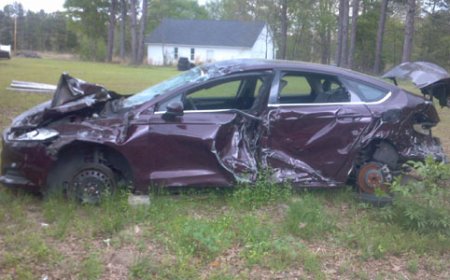From Engine Oil to Earth Impact: How Car Recycling Shapes Sustainability
Learn how recycling old vehicles helps protect nature, conserve resources, and reduce waste. Discover the real effect of car recycling in Australia. | Sell My Car Brisbane

Every machine comes to the end of its life. Cars, whether driven across long highways or kept for short trips in the suburbs, eventually wear out. When they do, many are either parked and forgotten or sent straight to landfill. What happens next, however, can make a large difference to the environment.
Car recycling plays a major role in reducing waste and cutting down the impact vehicles leave behind. The process reaches far beyond removing parts. From draining fluids like engine oil to breaking down metals, each step shapes how resources are reused and how nature is protected.https://getcashforcarz.com.au/
The Hidden Impact of Cars After Use
A car does not stop affecting the world once it stops running. Fluids such as engine oil, brake fluid, and transmission liquid can leak out and pollute soil or waterways. Tyres, plastics, and synthetic fabrics take many years to break down, often releasing small particles into the air and water.
According to the Australian Government's National Waste Report, more than 500,000 vehicles reach their end-of-life stage each year. Without proper handling, these machines become a growing source of waste and pollution. That is why car recycling is so importantit stops harmful materials from being left in places where they can do damage.
The Role of Fluids in Car Recycling
One of the first steps in recycling a vehicle is draining its fluids. Cars hold several types of liquids, each with its own risks. Engine oil can contain heavy metals. Coolant can be toxic. Brake fluid and transmission liquid can cause skin burns and contaminate soil.
Scrap yards and recycling facilities use safe storage and disposal methods. These liquids are collected, filtered, and sometimes treated for reuse. By keeping these substances out of the ground, recyclers reduce health hazards and protect plants and animals.
Recycling a single car properly may stop up to 40 litres of fluids from entering the environment. Multiply that by the number of vehicles processed each year, and the impact becomes clear.
How Metals Are Recovered and Reused
Cars are built with steel, aluminium, copper, and other metals. Mining for these raw materials often destroys land and uses large amounts of energy. Recycling old vehicles helps reduce the need for new mining.
Steel is the main metal recovered from scrapped vehicles. It can be melted down and shaped into new parts for buildings, roads, or even other cars. Aluminium from wheels or engines is also reused, saving energy compared to making it from scratch.
The recycling of one tonne of steel saves nearly 1.5 tonnes of iron ore and 0.5 tonnes of coal, according to data from the Australian Steel Institute. Every car that is recycled properly supports this saving.
Plastic and Rubber Recovery
Beyond metal, cars also contain many other materials. Plastic is found in dashboards, door trims, bumpers, and fuel tanks. Rubber is mostly found in tyres, seals, and hoses.
These items can be removed during the dismantling stage. Plastics may be sorted, shredded, and processed into pellets for reuse. Rubber from tyres can be ground into fine particles and used in road surfacing or sporting tracks.
By removing and recycling these parts, less rubbish ends up in landfills, and fewer new materials need to be made.
The Link Between Car Recycling and Lower Carbon Emissions
Recycling does not just reduce waste. It also cuts down greenhouse gas emissions. When metal, plastic, and rubber are reused, there is less need for new production, which often uses coal, oil, or gas.
By avoiding the mining and smelting of new metals, the carbon output is lowered. Even the act of collecting old vehicles and breaking them down uses less energy than producing new car parts from raw materials.
Reports from the Climate Council suggest that metal recycling is one of the most energy-saving recycling activities. That makes car recycling one of the quiet achievers in Australias fight against climate change.
Community Impact and Local Business Support
Car recycling also supports local economies. Dismantling yards, scrap metal centres, and parts resellers all rely on the flow of old vehicles. This creates work for mechanics, drivers, sorters, and machine operators.
Spare parts removed from recycled vehicles are used by workshops and car owners who need replacements. This keeps older cars on the road without needing to make new parts, which saves both materials and labour.
In Brisbane and nearby areas, those looking to get rid of old vehicles often use local services. When someone decides to Sell My Car Brisbane, they often do so through a collection service that passes the car on to licensed recyclers. This creates a smooth path from driveway to recycling yard and makes sure the vehicle is handled in a way that meets safety and environmental rules.
Why It Matters to Act Early
Holding on to a broken car for too long can create problems. Fluids may leak, parts may rust, and the car becomes harder to move or recycle. The longer it sits unused, the more chance there is for damage to the ground or risk to others nearby.
That is why it makes sense to take action once a car stops working. A service like Get Cash for Carz can help by collecting the car and passing it to the right team. These services often work with licensed yards, making sure each part is handled the correct wayfrom the engine to the last bolt.
This not only clears up space at home but also supports a cleaner and safer environment.
How to Prepare a Car for Recycling
If you are ready to send your vehicle for recycling, a few simple steps can help:
-
Remove all personal items from the car.
-
Take out any documents, tools, or belongings in the boot or glove box.
-
Take off the licence plates and return them to your local transport office.
-
Let the removal service know about the cars condition and any missing parts.
These steps help the process move without delay and ensure the car can be handled properly at each stage.
Final Words
Car recycling does more than just clear out space in your driveway. It plays a key role in shaping how we deal with waste, energy use, and natural resources. From engine oil to steel panels, each part of the vehicle has a place in the recycling process.
By taking action early and using the right removal service, you can make sure your old car becomes part of a cleaner cycle. That decision supports not just the environment but also local jobs and safety in your area.
Whether your car is worn, wrecked, or simply no longer needed, recycling it the right way makes a real and lasting difference.



























